wikiHow is a “wiki,” similar to Wikipedia, which means that many of our articles are co-written by multiple authors. To create this article, 31 people, some anonymous, worked to edit and improve it over time.
There are 8 references cited in this article, which can be found at the bottom of the page.
This article has been viewed 63,884 times.
Learn more...
The French horn is an elegant and complex instrument. The term “French horn” is actually a misnomer, as the modern version heralds from Germany.[1] Musicians and others in the United States continue to call the instrument a “French horn,” although it is typically known simply as a horn elsewhere in the world. This instrument is available in many different styles and models, which allow for a variety of playing ranges.[2] Beginning players tend to use single horns, which are lighter and less bulky, while professionals and other experienced players tend to use double horns.
Steps
Tuning your Horn
-
1Locate your tuning slide(s). A single horn generally has one main tuning slide. To locate this tuning slide, follow the tubing of your horn from the mouthpiece until you arrive at a tuning slide. This is your main tuning slide.
- If your horn has more than one tuning slide, you likely have a double horn and you will also need to adjust the B flat tuning slide.
-
2Warm up your instrument. Play your instrument for at least 3 to 5 minutes, going through scales or practicing musical and fingering patterns or even just blowing warm air through the instrument, a cold instrument never plays as well, this is all to warm up your own playing as well as the instrument. Also cold air temperature will make an instrument react and play differently, tending towards playing flat. The instrument will also warm up as you play, and the tone will shift slightly and become more predictable.[3]Advertisement
-
3Use a tuning instrument to play an F above middle C. Tune your horn to match the arrangement in which you're playing. In order to match the tune that the rest of the orchestra or ensemble is playing, match your tone to a consistent tuner (usually the oboe), it is best if the other hornists in your ensemble are there and you can all match the same pitch. Alternately, use a bar or electric tuner, tuning fork or even a well tuned piano..
-
4Listen to see if you match pitch. The approximate position for the main tuning slide is about ¼ inch to ½ inch out. With the tuning slide all the way in, the notes should sound sharp, with it all the way to it is flat. You can listen to your tuner's pitch and yours to determine if you are sharp or flat.
-
5Play the horn to match the tuning instrument's note. If the piano is playing F above middle C, play the corresponding open note (meaning there are no valves being pressed). Play the third C that would correspond with the middle C on a “horn in F.”
-
6Keep your right hand in the horn's bell. You will want to tune the horn to match the sounds that will emerge when you play it in performance. Keep the positioning and size of your hand's coverage in the bell consistent as you tune.
-
7Adjust the main F tuning slide. As you play this open note with the piano or other tuning instrument, you will hear if your note is flat (below the note) or sharp (above the note). Pull the tuning slide out to draw down sharp tones, or push the slide in to push up flat notes. It might take practice to hear if your pitch is right or wrong, it is a difference but it seems small at first Even though these are minor adjustments, they do impact how much air must travel through the horn and therefore impact how the tone sounds.
-
8Tune the B flat slide. If you are playing a double horn, your next step is to tune the horn so that it's in tune with itself. Press the thumb valve to switch over to the horn's B flat side. Play F again above middle C on piano. Slide between the F and Bb on the horn. Leave the main tuning slide alone and only adjust the Bb tuning slide the same way as the F slide.
-
9Tune the horn's closed notes. You have now tuned the open note (notes played with no valves pressed down). Now you need to tune closed notes, or those that are played while pressing valves down. You can use an electronic tuner, piano, tuning fork, or similar instrument to help you, but you can also use your ear to listen for sharp or flat notes.
- Play your middle C, which you just tuned. This should be perfectly in pitch now.
- Play either fourths, fifths or an octave above the tuned middle C for each valve. For example, to tune first valve, play F above your middle C. It is much easier to compare notes with middle C and hear the intonation between notes that are distant from each other, such as an octave apart.
- Adjust the valve tuner for each valve note you play to sharpen or flatten the note. To sharpen, push the slide valve tuner in. To flatten, slide the valve tuner out.
- Repeat for each valve. For a double horn, you should have six valves (three on the F side and three on the B flat side).
-
10Ensure you have enough coverage with your hand in the bell. If you have pulled out all the tuning slides and the horn is still sounding too sharp, then you likely need to provide more coverage with your right hand inside the horn's bell. Similarly, if you have pushed in the slides all the way and you are still flat, then you will need to adjust how much of your hand is inside the bell, instead making the coverage area smaller.
-
11Mark your tuning slides with a soft-leaded pencil. Mark the slides after you've tuned and adjusted the slide. This will give you a good indication of where the slide should sit to be in tune, although you will still need to tune your horn in comparison to the other instruments with which you are playing.
- Marking your slides is especially useful for when you need to empty condensation or saliva from the horn in the middle of a performance. Emptying condensation will usually throw off the pitch a bit. To offset this, make sure you take note of where you've put the valve mark so you can return the tuning slide to the correct location quickly. Alternately, you can measure where the tuning slide sits with your fingernail or knuckle and easily return the slide to its proper location after emptying condensation.
-
12Be ready to compromise. The complexity of the French horn is such that you cannot achieve perfect pitch for every note. You will need to compromise by choosing the middle ground on tuning.[4]
Changing your Pitch with Playing Techniques
-
1Change your embouchure. Your embouchure is your mouth position and movement through which air flows into the horn's mouthpiece. Using muscle control and air flow through the instrument, you can bend a note up or down to align it into tune more accurately. You can also adjust your lips or tongue to achieve slightly different pitches of the same note.
-
2Move your right hand in the horn's bell. The pitch of your horn changes depending on the placement of your hand in the bell. If you have small hands and a large bell, this can be problematic to cover enough of the bell to achieve good pitch. Similarly, larger-than-norrmal hands can also cause problems. Find a horn with a good fit for you. Test out the placement of your hand to adjust the pitch. More hand coverage will make tone flatter. Less hand coverage will make tone sharper.
- You can also use a tuning sleeve, which is like a cork or a bit of extra hand coverage. This will provide consistent and even coverage of the bell, which can help with pitch changes.[5]
-
3Change your mouthpiece. Mouthpieces are available in various cup sizes and shapes, and various rim widths, sizes and shapes. Selecting a different mouthpiece may enable you to reach new sounds or play with better tonal quality. If you have a mouth that is smaller or larger than average, this can impact how you play and you should adjust your mouthpiece accordingly.[6] You can also pull out or push in the mouthpiece slightly to adjust the pitch.[7]
-
4Practice frequently to learn proper pitch. Learning more about the horn, practicing consistently and often, and listening to others play the horn will give you a good sense of what sounds right.[8] Practice with an electronic tuner to see how accurately your ear hears a note's pitch. Play an open note without looking at the tuner and make adjustments to get the note into tune. Then check with the electronic tuner to see how close you are to the accurate pitch. Make an adjustment to align with the tuner and listen to how that note sounds.
-
5Play with an ensemble. This will help you stay in pitch more so than if you play solo. [9] You can adjust your tone to match your fellow players. You can also hide an out-of-tune note a little more easily when you play with others.
Taking Care of your Instrument
-
1Do not eat or drink anything while playing the horn. This is a complex and expensive instrument, and even minor damage can affect how it plays and the quality of its tone. Don't eat or drink anything, especially sugary soda or candy, just before or during when you will play the instrument. This can damage the horn. It is a good idea to brush your teeth before playing the horn to ensure that there is no transfer of food into the horn.
-
2Maintain the valves on a weekly basis. Keep your instrument in good condition by maintaining its moving parts frequently. To oil the valves, use a valve oil or rotor oil (available at a music shop) under the valve caps, along the bearing, and along the valve springs. Also, run warm, soapy water through the valves once a month to clean out any build-up. Wipe the valves clean and dry with a soft cloth. Grease the valves with a slide lubricant.[10]
-
3Clean the horn regularly. The outside of the horn will get coated with oils from fingers, while the inside will become coated with saliva and other moisture. This can contribute to a potential build-up of mold or other growths, thereby impacting the quality of the horn's sound and the longevity of the instrument itself. Clean the inside of the horn by washing out the tubes periodically. Use warm soapy water to flush out the tubes, which will clean out any built-up saliva and moisture. Rinse carefully with warm clear water and dry the instrument with a soft cloth.
Community Q&A
-
QuestionWhat if I don't have a piano?
 Community AnswerThere are free tuning apps as well as websites for tuning. A cheap tuner can also be purchased at your local music store.
Community AnswerThere are free tuning apps as well as websites for tuning. A cheap tuner can also be purchased at your local music store. -
QuestionWhat note on a French horn matches concert B flat?
 Community AnswerF natural on the French horn (with the horn in F) is the equivalent to a concert pitch B flat.
Community AnswerF natural on the French horn (with the horn in F) is the equivalent to a concert pitch B flat.
References
- ↑ http://thehub.musiciansfriend.com/band-orchestra-buying-guides/french-horn-buying-guide
- ↑ http://thehub.musiciansfriend.com/band-orchestra-buying-guides/french-horn-buying-guide
- ↑ http://hornmatters.com/2010/07/hornmasters-on-intonation/
- ↑ http://hornmatters.com/2010/07/hornmasters-on-intonation/
- ↑ http://hornmatters.com/2012/05/review-the-tuning-sleeve/
- ↑ http://www.thefrenchhorn.net/faq.html
- ↑ http://hornmatters.com/2012/03/mouthpieces-and-the-descant-and-triple-horn-part-ii-a-review-of-the-moosewood-bd-and-osmun-haydn/
- ↑ http://www.public.asu.edu/~jqerics/Pocket.htm
- ↑ http://www.public.asu.edu/~jqerics/Pocket.htm



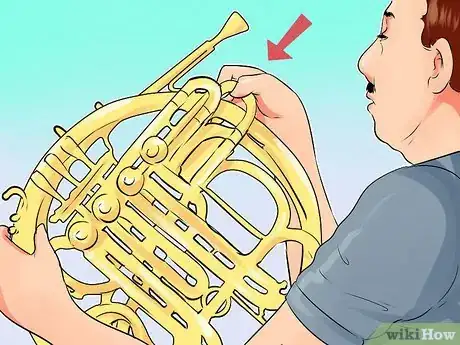

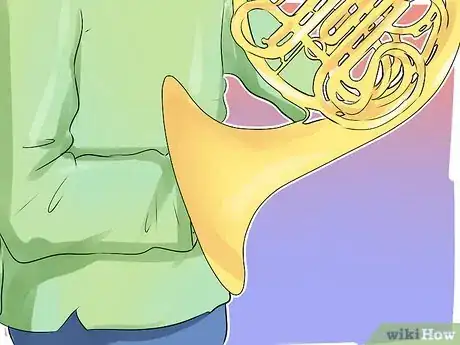
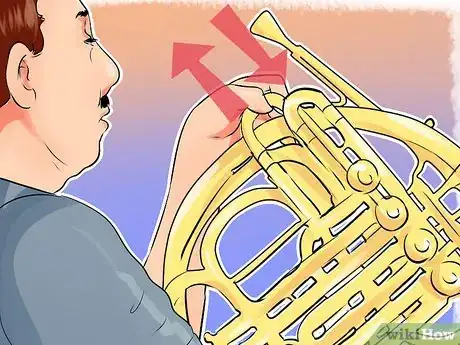
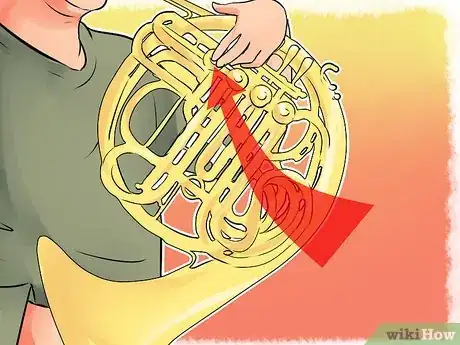










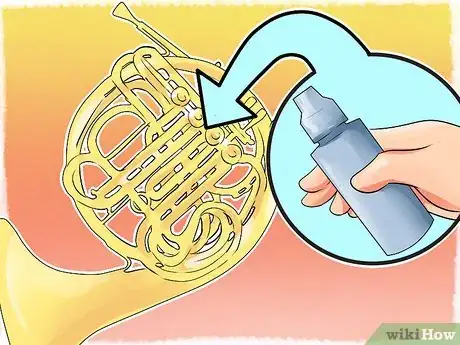
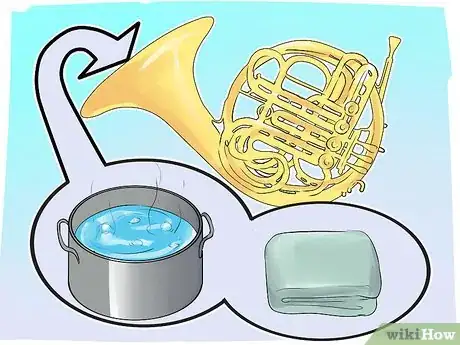





-Step-17-Version-4.webp)














































